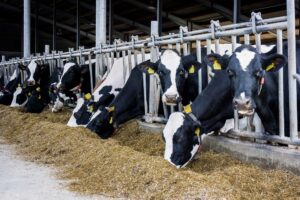“A lot of people underestimate the time it takes to become established and how quickly you build your business depends on using your time, investment and resources wisely,” says Katie Olthoff, co-founder of ChopLocal, an online farmers market that offers products from 45 farmers and butcher shops.
Through a series of webinars, ChopLocal taps experts for tips on how to market meat online directly to consumers.
1. Develop a Marketing Strategy
A marketing strategy gives you a sense of direction and purpose. It directs your marketing time and attention, increasing efficiency. “Marketing is the process of understanding what the consumer wants, developing the product, and getting it to them,” says Matt LeRoux, extension associate at Cornell University in his Marketing 101: How to Sell Your Meat Online webinar.
The first step is to identify your product and your targeted consumer. Learn what motivates them.
A marketing strategy needs to be specific .LeRoux says, “Focus on the bullseye in the middle of the target. You will attract others from the outer rings.”
Set specific objectives that include the audience, a measurable goal, timeline, budget, and specific action required. Objectives don’t have to be sales based. They may be goals for customer contacts or social media posts.
A crucial underlying component to a marketing strategy is defining your mission. You want to differentiate your positions and your farm in a way that attracts your target customers.
You need to tell consumers what you stand for, because they care.
2. Understand the Consumer
“The consumer of old is changing. Today’s consumer reads labels and asks questions,” says Roxi Beck with the Center for Food Integrity in Know, Like and Trust: What Today’s Consumers Want to Know About Your Farm. “They care about your ethics, your farming practices, how you treat employees, and participate in your community.”
They care about the environment, animal welfare, and sustainability with its many varying definitions.
They care about their personal health.
“Price, convenience, and taste will always be factors in purchase decision making,” says Beck. “But today’s consumers want more. Food choices are a complex monster. Today’s consumer wants you to be able to talk about who you are and why you do what you do before you talk about the facts.”
Beck cites research showing 39% of consumers consider environmental sustainability when making purchases, a 12% increase since 2019; 52% believe their purchase will impact the environment.
That requires a level of transparency that Beck says makes some producers uncomfortable. But it is essential in gaining consumer trust – and, as she adds, “trust will get you sales.”
Market research can help identify consumers and their desires and helps you market products to those who already value them. Collecting data from the vendors in their network, ChopLocal found their most consistent and prolific customers were in the age 45-60 demographic, not the younger set they assumed.
“The goal should be to pull customers in, not push them toward your product,” says LeRoux. He adds
there is little value in attempting to educate the consumer as to why they should buy your product. “They already have thoughts on that. It’s more important to understand than to educate.”
Perhaps the best way to discover how the consumer thinks is to listen.
Conversations at the farmers market, online, or with your friends and family, are portals to invaluable feedback. When you post on social media, read the comments to glean insights.
What message resonates with them? How can you give that back to them in product and services?
When a customer’s questions seem silly or irritating, keep in mind they most likely don’t know enough to ask a more informed question. Ag vernacular may be confusing to them (like the definition of sustainability).
Try to feel them out as to what they really want to know. Are they really concerned about the use of antibiotics in animals, or are they concerned about their own health?
3. Develop your Product
To successfully market your product to consumers, you must have a product consumers want to buy.
Familiarize yourself with the local market. Browse websites of existing online marketers to see what items are offered, and which ones appear to move.
Seek out expertise.
Then, if need be, adjust your product to what your consumers are telling you they want.
LeRoux gives the example of a producer selling freezer beef. He was hearing from customers that it was hard for a family to write one big check for a half or quarter of beef, even though it was a good price per pound. He adjusted and began selling smaller bundles.
Remember your product plan must include profit.
In Profitable Meat Marketing LeRoux offers a new Cornell University meat pricing calculator that can help you work through strategies to get the profit you need.
4. Make Yourself Seen
“Let consumers know you are there and have the product they’re looking for,” says LeRoux.
Invest in branding. Develop a logo and color scheme so you are easily recognized in print, on-location signage, and social media.
The past few decades have changed the way we consume information, creating opportunity to share your message beyond traditional advertising.
Social Media
Social Media outlets such as Instagram, Facebook, and Pinterest, provide an option for reaching your targeted consumer with minimal cash outlay. YouTube videos are another creative outlet. Targeted advertising is available at reasonable costs.
Start your sharing with friends and family and let their network help you build your following.
Connecting with specific community pages allows you to target your message to the group’s interest and engage with its members.
Facebook offers sharable “events” for your farmers market appearance, an on-farm store sale, or a virtual event that invites a targeted audience and sends a reminder – another opportunity to share.
Make sure your information is clear, concise and consistent. A link to complete the sales process is important
Keep messages positive. Avoid whining or guilt trips.
Stories, quizzes, polls, expert advice, foodies and influencers, live videos all make effective posts. Switch it up. Try new things. Entertain. The more variation, the more ways people can engage.
Photography
Photos are the most effective way to catch the consumer’s eye. They can be used to showcase product and give insight into your farm.
Farm Marketing Mentor Victoria Robinson, in Using Social Media to Sell Direct to Consumers, says people like photos of people, livestock (especially newborns), daily activity, and farming.
“When sharing real life adventures, it is best to document – not create,” says Robinson. “Don’t make it harder than it is. They want to see you and what you do, not what you set up for them to see.”
Always highlight the best animal care practices.
Engage Other Accounts
Share photos of activities that include other people, and have them share, too. “Seize the spider web effect to get your name in front of as many potential customers as possible,” says Robinson.
Use social media posts to thank customers. “Showing appreciation is a way to show others you have happy customers,” says Olthoff.
Educating the consumer may not be a good overall marketing strategy, but it is useful when it helps them get what they already want – like a recipe to cook an unfamiliar cut of meat, or a new way to cook a familiar one, maybe in an ethnic dish.
Always give credit and link to the original recipe source, says “Dance Around the Kitchen” blogger Kelsey Byrnes in Food Photography and Sharing Recipes.
5. Stay engaged
In any social media campaign, engagement is more important than “likes.”
“It’s not a numbers game,” says Robinson. “It’s not about going viral. It’s about having a group of loyal customers.”
Social media is a form of customer service. When you use social media as a marketing tool, you create a platform that requires attention and nurturing. Posting is making a commitment to respond and engage.
Just like greeting returning customers at the farmers market with a hearty hello and a warm smile, it’s about building long term relationships and selling people what they want.
Learn More
The ChopLocal webinar series is Phase 1 of a 3-year public relations and marketing program through a USDA Farmers Market Promotion Program grant. The full series is available at no cost at Sell.ChopLocal.com
List of webinars:
Marketing 101: Selling Meat Online – Matt LeRoux, Extension Associate with Cornell University
Using Social Media to Sell Direct to Consumers – Victoria Robinson, Farm Marketing Mentor
Know, Like and Trust: What Today’s Consumers Want to Know About Your Farm – Roxi Beck, The Center for Food Integrity
Food Photography and Sharing Recipes – Kelsey Byrnes, Dance Around the Kitchen
Profitable Meat Marketing – Matt LeRoux, Extension Associate with Cornell University







:max_bytes(150000):strip_icc()/Red-Meat-for-Inspection-USDA-2000-49edabc9841e47f6a0b56aa35707f37c.jpg)
:max_bytes(150000):strip_icc()/Alisha-John-Deere-combine_web-b60ecafb670443e3a31f0058936004bd.jpg)
:max_bytes(150000):strip_icc()/Belinda20Burrier20hue-2-2000-eec85f5575e24143b044a93577938a30.jpg)
:max_bytes(150000):strip_icc()/SF20Podcast20114_thumbnail-e872571374dc46a18bba88cc77984aa9.jpg)
:max_bytes(150000):strip_icc()/Farmers20for20the20Future_Up20by20his20Bootstraps-Justin20copy-6f000503334e464d9b5ca9576af383fb.jpg)
:max_bytes(150000):strip_icc()/garrett_illustration-569eeea71d734d18ab6fdb125e0da3b0.png)
:max_bytes(150000):strip_icc()/SFpodcast20drones20weed20application-3019ca79bb3d4af0aa26b357925d1f15.jpg)